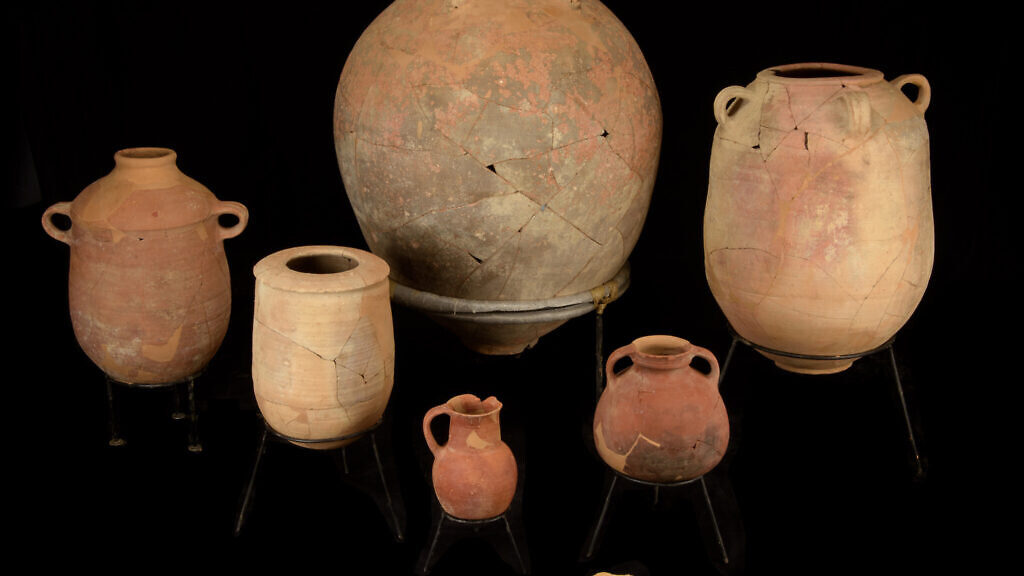It is always amazing when the archaeological evidence proves the known recorded facts about Jerusalem! The writings in the Tanach (the comprehensive Jewish Biblical writings) recorded the history of the Jewish people, Jerusalem and all of Israel. It’s a beautiful thing to watch these facts proven by evidence that was buried thousands of years ago…
Photo: Vessels discovered in Jerusalem’s City of David within a layer of destruction from the 8th century BCE, which coincided with a massive earthquake mentioned in the Bible. They are photographed after their restoration by Joseph Bocangolz. (Dafna Gazit / Israel Antiquities Authority)
Archaeologists unearth 1st Jerusalem evidence of quake from Bible’s Book of Amos
Article Courtesy: Times of Israel
The multi-year coronavirus pandemic is now firmly branded as a benchmark in modern memory. Likewise, in the first verse of the Book of Amos, the 8th century BCE biblical prophet referred to “two years before the earthquake” as an anchor to the events he was about to relate. Two centuries later, the prophet Zechariah again referred to this destructive earthquake period, so deeply was it ingrained in the collective psyche.
Now, for the first time, a team of Israel Antiquities Authority archaeologists in Jerusalem’s City of David report that they have found unprecedented concrete evidence of this 8th century BCE earthquake in the ancient capital.
In an upcoming research paper, the archaeologists chart, for example, that in one particular 8th century BCE structure the destruction layer did not show signs of fire, yet other factors suggested the building had been damaged in a traumatic event, apparently an earthquake. “This was most notable on the earliest floor of the southernmost room,” they write. “In this room, a row of smashed vessels was uncovered along its northern wall, above which fallen stones had been found. It appears that these stones were the upper part of the walls of the room, which had collapsed, destroying the vessels which had been set along the wall.”
Until now, the earliest destruction layer of Jerusalem comes from the Babylonian conquest of 586 BCE. For archaeologists, an earlier historical anchor — if proven through hard, securely dated evidence — serves as an important stratigraphical benchmark for scientific excavations in Jerusalem.
According to Tel Aviv University Prof. Israel Finkelstein, who was not involved in the current research, “destructive earthquakes in Jerusalem are possible, as shown by the well-recorded earthquake of 1927… The early layer of the book of Amos includes materials which relate to the 8th century and hence it is possible that a devastating earthquake left a strong impression and was recorded.”
Through decades of research, archaeologists and seismologists have successfully documented the historical veracity of such an earthquake event that spread throughout the Kingdom of Judah 2,800 years ago. For example, at Finkelstein’s Tel Megiddo site, a similarly dated earthquake has been established after years of research tracing seismic activity in several periods, “including Stratum IVA which indeed dates to the first half of the 8th century BCE,” Finkelstein said.
But only in recent excavations led by Dr. Joe Uziel and Ortal Chalaf was this destruction layer discerned in Judah’s capital, Jerusalem. And it could be a real game-changer.
“It’s not that per se we’re providing here a way to date, but rather an anchor that we can compare what comes before and what comes after,” cautiously explained IAA excavation co-director Uziel. It is not a new tool or technology to independently date an object or layer, such as carbon-14 dating. However, “if I know I should be looking for some kind of destructive event in the middle of the 8th century then I know what comes before and after,” said Uziel, who today also heads up the IAA Dead Sea Scrolls Lab.
Read the Full Article

 Join Now
Join Now Sign Petition
Sign Petition Tell Friends
Tell Friends








